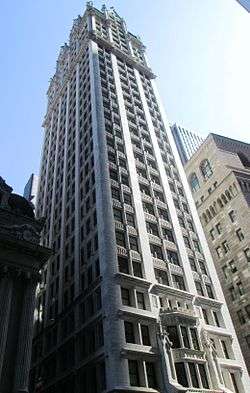Liberty Tower (Manhattan)
|
Liberty Tower | |
|
(2013) | |
 Liberty Tower  Liberty Tower  Liberty Tower | |
| Location |
55 Liberty St. Manhattan, New York City |
|---|---|
| Coordinates | 40°42′32″N 74°0′34″W / 40.70889°N 74.00944°WCoordinates: 40°42′32″N 74°0′34″W / 40.70889°N 74.00944°W |
| Built | 1909=10 |
| Architect | Henry Ives Cobb |
| Architectural style | Gothic |
| NRHP Reference # | 83001734[1] |
| Significant dates | |
| Added to NRHP | September 15, 1983 |
| Designated NYCL | August 24, 1982 |
The Liberty Tower, formerly the Sinclair Oil Building, is located at 55 Liberty Street at the corner of Nassau Street in the Financial District of Manhattan, New York City was built in 1909–10 as a commercial office building and was designed by Chicago architect Henry Ives Cobb in a Gothic Revival style. It was built on a site adjacent to the New York City Chamber of Commerce Building (1901); the subsequent New York Federal Reserve Bank building was constructed to the east, across Nassau Street, in 1922. A completely free-standing 33-story building, in 1909 Liberty Tower was the tallest building in the world with such a small footprint. The limestone building is covered in white architectural terracotta ornamented with birds and alligators and other fanciful subjects.[2][3]
History
Before its construction in 1909, a prior building on the same site housed the offices of the New York Evening Post under editor William Cullen Bryant, and served as the first headquarters of the American Society for the Prevention of Cruelty to Animals, established by Henry Bergh in 1867.
President Theodore Roosevelt's law office was one of its first commercial tenants after the building opened in 1910. In 1917, an office was leased as cover for German spies seeking to prevent America's intervention in World War I (then called "The Great War"). The plot involved an attempt to draw the United States into a diversionary war with Mexico and Japan. The plot was exposed on March 1, 1917, with news reports of an intercepted telegram decoded by British cryptographers, the notorious "Zimmermann Telegram", which prompted President Woodrow Wilson to declare war against Germany a month later.[4]
Shortly afterward, the entire building was leased by the Sinclair Oil Company, responsible for the Teapot Dome scandal of 1922. Prior to the 1974 Watergate scandal, this was called "the most sensational scandal in the history of American politics," and became the most enduring legacy of Warren G. Harding's troubled presidency.
In 1979, the structure, renamed Liberty Tower, was converted from commercial use into a residential building, one of the first such conversions in Manhattan south of Canal Street, by architect Joseph Pell Lombardi.[5] It was designated a New York City landmark in 1982, and was added to the National Register of Historic Places on September 15, 1983.
Because the then new principles of "skyscraper" design were not yet fully understood, the building was overbuilt, with its steel foundation anchored deeply into bedrock five stories below street level. This overly sturdy construction helped this tall, slender building withstand the collapse of two World Trade Towers only 220 yards to the west on September 11, 2001, with only minimal damage despite the impact which was measured at the time as a 3.3 magnitude seismic event.
A restoration of the building was undertaken from 2007 to 2009.[6]
See also
- List of New York City Landmarks
- National Register of Historic Places listings in New York County, New York
References
- ↑ National Park Service (2009-03-13). "National Register Information System". National Register of Historic Places. National Park Service.
- ↑ New York City Landmarks Preservation Commission; Dolkart, Andrew S. (text); Postal, Matthew A. (text) (2009), Postal, Matthew A., ed., Guide to New York City Landmarks (4th ed.), New York: John Wiley & Sons, ISBN 978-0-470-28963-1, p.13
- ↑ White, Norval; Willensky, Elliot & Leadon, Fran (2010), AIA Guide to New York City (5th ed.), New York: Oxford University Press, ISBN 9780195383867, p.39
- ↑ Barbara Tuchman, The Zimmermann Telegram, 1985.
- ↑ Joseph Pell Lombardi Architects
- ↑ Arieff, Irwin (April 2, 2010). "Liberty Tower: A Storied Skyscraper With Much to Celebrate". nytimes.com.
External links
 Media related to Liberty Tower at Wikimedia Commons
Media related to Liberty Tower at Wikimedia Commons- Liberty Tower at CityRealty


